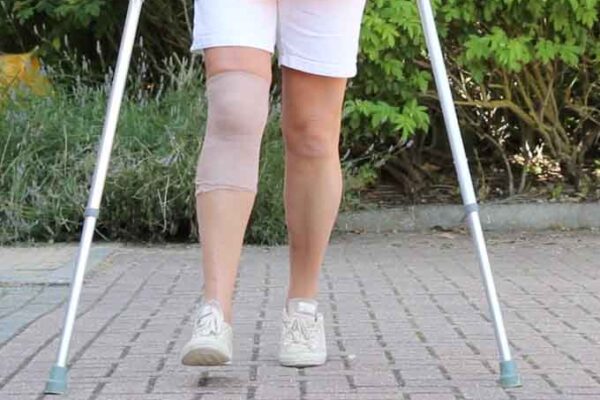Crutches will be given to you in the event of an injury or after surgery to the lower limb. They are less stable than a frame and more stable than walking sticks. If you have problem with balance you will start on a frame and progress to crutches.
You will be supplied by the hospital, who should measure them correctly for you. In the event that they are not involved or you think they are wrong, the method of measuring the correct height is to stand with your arm relaxed by your side. The handle of the crutch should be level with your outside wrist bone.
How you walk with the crutches depends whether you are allowed to put your foot on the ground at all ( Non weight bearing)or if you are allowed to put the foot down but with less than full weight going through the leg(partial weight bearing).
Walking with crutches is extremely hard work and it is important to do it correctly to avoid extra strain on the back, legs and arms.
With the handles facing forwards and the crutches well out from the body to avoid tripping on them. Keep the crutches steady by keeping the handles facing forwards at all times.
If you are Non weight bearing-
Bring both crutches forwards with the non weight bearing leg and then if able move the good leg all the way through as if walking normally.
If this is too difficult start initially just bringing it up level with the crutches.
If you need to turn do it slowly with lots of little hops and avoid twisting too much on your good leg.
See video link below
With Partial weight bearing
In this case you are allowed to put some weight through the injured leg.
Move the crutches forward at the same time as the bad leg so they are all in line with each other. i.e do not move the crutches further forward than the step you intend to take! Put some weight through the bad leg and the crutches.
Then bring the other foot through like a normal step so ideally going past the bad leg and the crutches.
see Video
Stairs with Crutches
Going upstairs-
Get close to the bottom step
Hold the bannister with one hand.
Place the crutch that would have been in that hand in the other hand horizontally assuming you have the ability to grip it with the other one.
If not someone will have to carry it up or you will need a second pair of crutches upstairs.
Remember the rhyme GOOD LEG UP TO HEAVEN
Place the good leg up on the step.
Then push up on the good leg and lift the bad leg and crutch to join it.
Continue on until you reach the top.
Downstairs with crutches
This can the first few times be a little more frightening. If you do feel yourself wobbling it is always to sit back down on the steps and if necessary come down on your bottom.
The method of doing it with the crutches is to hold the bannister and the 2 crutches in the other hand.
Remember the rhyme BAD LEG DOWN TO HELL
Put the crutches down one step with the bad leg.
Then join it with the good leg.
see Video
The method is the same non weight bearing but much harder work and you must not put your foot to the ground.
If you feel too frightened it is best to go up and down on your bottom or have someone behind you on the way up and in front of you on the way down.
Kerbs and Steps with no rail
The basic same method applies
Going UP-
Approach the kerb and get nice and close to it. You keep both crutches in your both hands as you would on the flat. Going up you put the good leg up first and then follow with the crutches followed by the bad leg.
Coming DOWN–
To come down do the reverse-
Get close to the edge of the step. Put the crutches and the bad leg down and follow with the good one
What do I do if I am too good for 2 crutches?
The next progression is to drop one crutch. This is still partial weight bearing if done correctly.
The natural pattern for the body is to walk opposite arm to leg.
The crutch that you drop is the one the same side as your injury.
Therefore when you walk you put the crutch on the unaffected side forward at the same time as the bad leg. Push through the crutch and then walk through with the good leg.
Try and keep the steps a normal consistent size- ie the same size steps with both affected and non affected legs.
To get up from sitting
Put both your crutches together handles facing each other. So they form an H
Push up with one hand on the chair and the other on the handles of the crutches. Then push up. Stand and get your balance and then move both crutches in to position.


Pingback: Knee replacement- Exercises – Myhealth4life